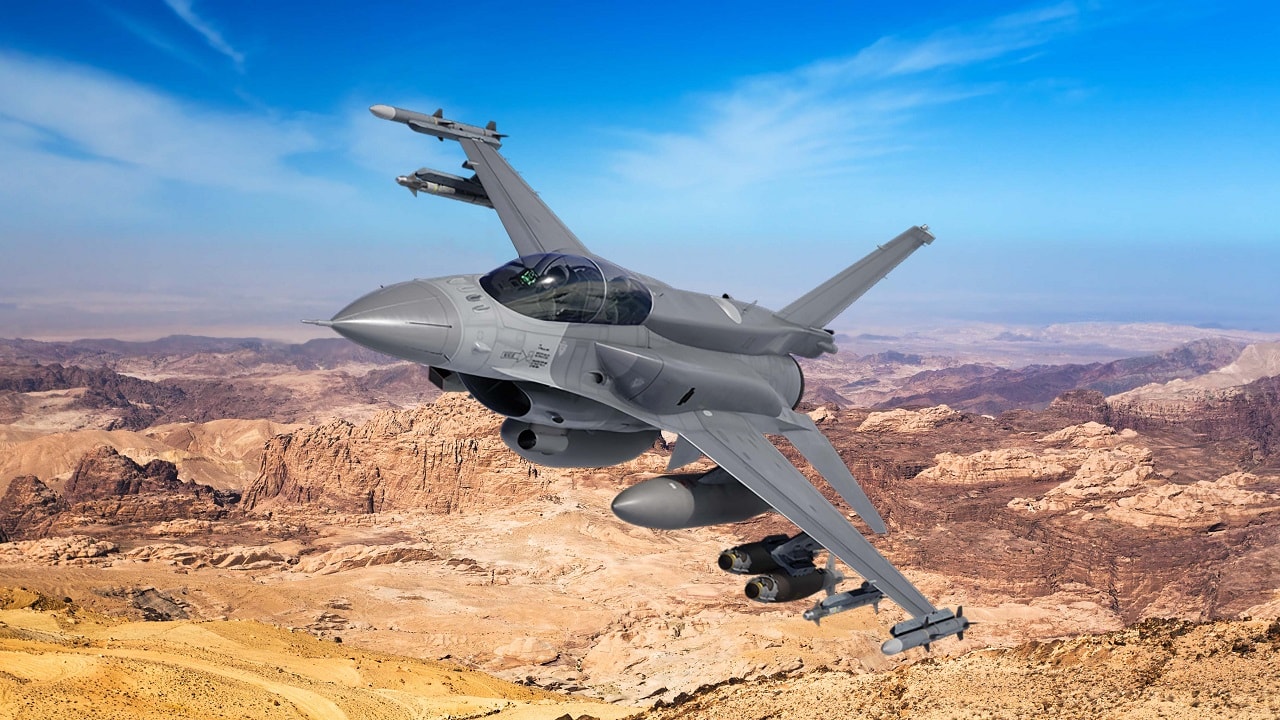In June, the Hashemite Kingdom of Jordan officially signed a Letter of Offer and Acceptance (LOA) for the sale of eight new production America F-16 Block 70 fighter jets. The signing of the LOA comes nearly four months after the Biden administration cleared the way for this arms package, which also includes various weapons and systems to arm the airframes.
The initial value of the deal was $4.21 billion for a total of 16 aircraft, 12 single-seat F-16Cs, and 4 two-seat F-16Ds. However, Jordan ultimately purchased eight fighters for a total of $2.1 billion. The U.S. State Department said the sale would positively impact the Jordanian Air Force’s ability to work effectively alongside the U.S. and other coalition forces. Since Jordan’s Air Force primarily uses the F-16A as its combat aircraft, the new Block 70 additions will modernize its force.
The Royal Jordanian Air Force Has Earlier F-16 Variants
The F-16 has represented the mainstay of the Royal Jordanian Air Force for years. Its fleet operates 43 F-16A and 18 F-16B Fighting Falcons today. Jordan received its first delivery of F-16s in the late 1990s after King Hussein signed a peace treaty with Israel ending over four decades of hostility between the two countries.
The U.S. signed a 220 million dollar agreement with the Hashemite Kingdom in 1996, authorizing the lease of 12 F-16A and 4 F-16B fighters to Jordan. Originally designed by General Dynamics (now Lockheed Martin), the F-16 Fighting Falcon first flew in the late 1970s Constructed to contend with the shortcomings of the airframes that operated in the Korean and Vietnam Wars, the Falcon was an air-superiority platform of its time.
Over the years, several variants of the F-16 equipped with enhanced specifications have emerged. According to Lockheed Martin, the Block 70/72 variant “combines capability upgrades, most notably the advanced Active Electronically Scanned Array (AESA) radar with a new avionics architecture, and structural upgrades to extend the structural life of the aircraft by more than 50 percent beyond that of previous production F-16 aircraft.
F-16 Block 70 software takes advantage of technologies not available when earlier Block F-16s were developed and produced. Operational capabilities are enhanced through an advanced datalink, targeting pod and weapons; precision GPS navigation and the Automatic Ground Collision Avoidance System (Auto GCAS).” These advanced capabilities will serve to modernize the Royal Jordanian Airforce.
The Royal Jordanian Fleet
With 230 airframes in its arsenal, Jordan’s Air Force possesses decently large fleets. In addition to its 61 F-16s, its fleet holds McDonnell Douglas MD500 Defender and Bell Ah-1 Cobra helicopters, Lockheed Martin C-130 Hercules transport aircraft, Pilatus PC-21, and other foreign aircraft.
Jordan utilizes its F-16s to carry out regional missions. In 2014, a Jordanian F-16 fighter was shot down by Islamic State fighters over Syria and the captured pilot was subsequently murdered in a brutal manner by the terror group. In 2017, Jordan’s F-16s launched 20 airstrikes on Islamic State targets partly in retaliation for the capture and execution of its pilot years earlier. The incoming 8 Block 70 airframes will improve the Royal Jordanian Air Force’s regional combat operations going forward.
The F-16s Could Be Part of a New Alliance in the Middle East
The signing of the LOA earlier this month coincided with King Abdullah II of Jordan’s declaration that he would support a Middle East version of the North Atlantic Treaty Organization (NATO). Alluding to the challenges regional players are facing, including Iran’s proxy endeavors, the king emphasized the need for a joint effort. Around the time of King Abdullah’s announcement, Israeli officials proclaimed that it had joined several of its neighbors in the region to form a new U.S.-led air defense program called the Middle East Air Defense Alliance (MEAD). Jordan is expected to be a part of this collaborative network.
According to figures published by a Globaldata budget analysis report, Jordan’s 2022 defense budget reached $1.9 billion and is expected to grow around 4 percent between 2023-2027. Due to regional challenges, it makes sense that Jordan is increasing its defense budget. In fact, last year saw overall military expenditures reach a record high of over $2 trillion. Nations are expected to grow their defense budgets even more this year, following Russia’s ongoing invasion of Ukraine.
Jordan’s ramped-up budget will likely prioritize cohesive air defense capabilities to contend with the threats posed by Iran and terrorist groups in the region. In his “NATO in the Middle East speech,” King Abdullah specifically referenced the role Shiite militias continue to play in the Middle East. He expressed that “Iran’s hostile actions along with its ongoing nuclear program are raising fears everywhere in the region and has transferred Iran into a common enemy or adversary to many Arab and non-Arab countries in the Middle East.” Similar regional coalitions have emerged in recent years in part to counter Iran’s malign behavior, including the Abraham Accords and the Al-Ula Declaration.
With modernized airframes in its fleet, Jordan is better positioned to join regional defense coalitions effectively. The incoming eight F-16 Block 70 fighters will undoubtfully become the mainstay of the Royal Jordanian Air Force.
Maya Carlin is a Middle East Defense Editor with 19FortyFive. She is also an analyst with the Center for Security Policy and a former Anna Sobol Levy Fellow at IDC Herzliya in Israel. She has by-lines in many publications, including The National Interest, Jerusalem Post, and Times of Israel.

